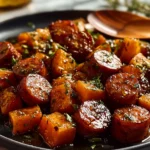Boiling chicken with rice is a simple, yet flavorful way to prepare a wholesome, balanced meal. The process involves cooking chicken and rice together in one pot, allowing the rice to absorb the chicken’s natural juices, creating a dish that’s both savory and satisfying. This method is not only easy but also reduces the number of dishes to clean, making it an ideal choice for busy individuals or families.
The benefits of boiling chicken with rice extend beyond convenience. It’s a nutritious meal that provides essential protein from the chicken and carbohydrates from the rice, making it well-balanced and filling. Additionally, this dish is highly versatile; you can easily customize it with different seasonings, vegetables, or types of rice to suit your taste preferences. Whether you’re an experienced cook or a beginner, boiling chicken with rice is an effortless way to create a hearty, delicious meal.
Why Boil Chicken with Rice?
Boiling chicken with rice is not just about convenience; it enhances the flavors of both the chicken and rice. As the chicken cooks, it releases juices that infuse the rice, creating a richly flavored, comforting dish. This method allows the rice to soak up the savory chicken broth, giving the rice an incredibly tender and delicious taste.
The dish also offers a perfect balance of proteins and carbohydrates. Chicken provides a lean source of protein, which is essential for muscle repair and growth, while rice delivers energy-sustaining carbohydrates. Together, they make a filling meal that can keep you satisfied for hours. Furthermore, adding vegetables or herbs can increase the nutritional value, making it a well-rounded meal.
This method of cooking is also versatile and can be adapted for various cuisines. From Asian-inspired chicken rice dishes to Latin American variations like Arroz con Pollo, boiling chicken with rice can be tailored to suit different tastes and dietary needs, making it a staple in many households.
Ingredients Needed
To make boiled chicken with rice, you only need a few basic ingredients:
- Chicken: You can use breasts, thighs, or even a whole chicken.
- Rice: Long grain, jasmine, or basmati rice works well, each adding its own texture and flavor.
- Water or Broth: Chicken broth adds more flavor, but water can be used for a lighter dish.
- Seasonings: Salt, pepper, garlic, and any herbs or spices you prefer.
Optional add-ins include vegetables like carrots, onions, or peas, which can boost the dish’s nutritional content and enhance the flavor. Feel free to adjust the ingredients based on what you have available.
Step-by-Step Guide to Boiling Chicken in Rice
Step 1: Preparing the Chicken
Before starting the cooking process, it’s important to prepare the chicken properly. Begin by cleaning the chicken under cold water to remove any impurities. Pat it dry with paper towels. You can use chicken breasts, thighs, drumsticks, or a whole chicken, depending on your preference. Once cleaned, season the chicken with salt, pepper, and any additional spices or herbs of your choice, such as garlic powder, paprika, or thyme.
For an extra layer of flavor, you can marinate the chicken for 30 minutes to a few hours before cooking. A simple marinade of olive oil, garlic, lemon juice, and herbs works well, but you can customize it based on your preferences. This step is optional, but marinating enhances the flavor and keeps the chicken moist during the boiling process.
Step 2: Choosing the Rice
The type of rice you choose will affect both the texture and cooking time. Long grain white rice is a popular choice because it stays fluffy when cooked. Jasmine rice offers a fragrant aroma and a slightly sticky texture, while basmati rice has a firmer, more distinct grain.
Brown rice is another option if you prefer a healthier, fiber-rich choice, but keep in mind it takes longer to cook. Wild rice, although not technically a rice, offers a nuttier flavor and chewy texture, but also requires more water and a longer cooking time. Whatever type of rice you select, it’s important to adjust the water-to-rice ratio and cooking time accordingly.
Step 3: Setting Up the Pot
Start by adding water or broth to your pot. For white rice, use a 2:1 water-to-rice ratio. For example, if you’re using 1 cup of rice, you’ll need 2 cups of water or broth. For brown or wild rice, increase the water slightly to 2.5 cups per cup of rice. Using broth instead of water adds more flavor to the rice as it absorbs the chicken’s juices during cooking.
Place the seasoned chicken directly on top of the rice. Make sure the chicken is partially submerged in the liquid to ensure even cooking. Add your chosen seasonings like salt, pepper, garlic, or bay leaves to enhance the flavor of the broth and rice.
Step 4: Boiling Process
Bring the mixture to a boil over medium-high heat. Once it starts boiling, reduce the heat to low and cover the pot. Allow the dish to simmer gently.
Check the internal temperature of the chicken using a meat thermometer to ensure it reaches 165°F (75°C). For the rice, test its doneness by checking for softness and absorbing most of the liquid. Depending on the type of rice, this should take 15-20 minutes for white rice or longer for brown or wild rice. Stir occasionally to prevent sticking at the bottom.
Step 5: Resting and Serving
After cooking, remove the pot from heat and let the dish rest for about 5-10 minutes. This allows the rice to finish absorbing the flavors and gives the chicken time to cool slightly for easier handling. Fluff the rice with a fork and, if desired, slice or shred the chicken before serving. Garnish with fresh herbs like parsley or cilantro for added color and flavor.
Variations of Boiled Chicken and Rice
- With Vegetables: Adding vegetables such as carrots, peas, spinach, or bell peppers not only enhances the flavor but also increases the nutritional value of the dish. Add vegetables during the last 10 minutes of cooking to keep them tender but not mushy.
- Spices and Herbs: For more flavor, you can experiment with different spices and herbs. Add garlic, turmeric, cumin, or ginger for an extra kick, or fresh herbs like parsley, cilantro, or rosemary. Spices like curry powder or chili flakes can add a bit of heat to the dish.
- Broth Instead of Water: Replacing water with chicken broth or vegetable broth makes the rice more flavorful as it absorbs the rich taste of the broth while cooking.
- Rice Varieties: If you want to change things up, try brown rice for a healthier alternative rich in fiber, or wild rice for a nuttier flavor. Keep in mind that these types of rice will require more cooking time and liquid.
- International Variations:
- Hainanese Chicken Rice: A popular Asian dish where the chicken is boiled separately, and the rice is cooked in the chicken broth for added flavor. Often served with a ginger-garlic dipping sauce.
- Arroz con Pollo: A Latin American version of chicken and rice, flavored with tomatoes, bell peppers, and spices like cumin or paprika for a vibrant, colorful meal.
Tips for Perfect Chicken and Rice
- Avoid Overcooking the Rice: It’s important to monitor the rice closely to prevent it from becoming mushy. Using the correct water-to-rice ratio and reducing the heat to low once boiling will help you avoid overcooking.
- Water-to-Rice Ratio: Different types of rice require different water amounts. White rice typically needs a 2:1 ratio, while brown and wild rice may need slightly more water. Be mindful of the type of rice and adjust the liquid accordingly.
- Using Leftover Chicken: If you have pre-cooked chicken, you can still make this dish quickly. Add the leftover chicken in the final 10 minutes of cooking just to heat it through, as overcooking pre-cooked chicken can make it dry.
- Adding More Flavor: Use broth instead of water and season your dish generously. Spices like cumin, paprika, and even lemon zest can elevate the flavor profile without overpowering the dish. You can also squeeze fresh lemon or lime juice over the finished dish for a burst of freshness.
- Keeping Chicken Tender: Boiling chicken slowly at a low simmer ensures that the meat stays tender and moist. Avoid cooking at too high a temperature, which can make the chicken tough and dry.
Common Mistakes to Avoid
- Too Much Water: Adding too much liquid can result in soggy rice. Stick to the recommended water-to-rice ratio for the specific type of rice you are using.
- Overcooking the Chicken: Boiling chicken for too long can lead to dry, tough meat. Always check the internal temperature to ensure it reaches 165°F but avoid overcooking.
- Underseasoning: One common mistake is not adding enough seasoning, which can make the dish bland. Taste as you go, and don’t be afraid to add more spices or herbs during cooking.
- Cooking at Too High Heat: Cooking at a high temperature can result in uneven cooking. The rice may burn at the bottom of the pot while the chicken remains undercooked. Always reduce the heat to a simmer after the mixture starts boiling.
Health Benefits of Chicken and Rice
Chicken and rice is not only a delicious dish but also a nutritious one. Chicken provides a high source of lean protein, essential for muscle growth and repair, making it an ideal choice for those looking to maintain a balanced diet. Rice, on the other hand, supplies carbohydrates that fuel the body with energy. This combination creates a well-rounded meal that keeps you full and satisfied for longer periods.
The method of boiling chicken with rice is naturally low in fat, especially if no oil or butter is added, making it a heart-healthy option. For those looking to reduce sodium or calories, this dish can be easily customized. Using low-sodium broth, minimal seasoning, or lean cuts of chicken like the breast can make the meal even healthier. Additionally, substituting white rice with brown rice or quinoa increases fiber content while maintaining the same hearty, satisfying meal.
Frequently Asked Questions
Can I use frozen chicken for this recipe?
Yes, you can use frozen chicken, but it will take longer to cook. It’s recommended to thaw the chicken before cooking for more even cooking. If you’re short on time, frozen chicken can still be used; just ensure you increase the cooking time and check that the internal temperature reaches 165°F (75°C).
Do I need to wash the rice before cooking?
Yes, it’s generally a good idea to wash rice before cooking. Rinsing the rice helps to remove excess starch, which can prevent the rice from becoming overly sticky. It also improves the overall texture of the dish, resulting in fluffier rice once cooked.
What kind of chicken is best for boiling with rice?
Thighs and drumsticks are ideal for boiling because they remain tender and juicy even when cooked for extended periods. However, chicken breasts also work well and offer a leaner option. If using breasts, be mindful of the cooking time to avoid overcooking and drying them out.
How can I prevent the rice from sticking to the pot?
To prevent rice from sticking to the pot, stir occasionally during cooking, especially in the first few minutes. Make sure there’s enough liquid in the pot to cover the rice and chicken. If sticking persists, using a non-stick pot or adding a small amount of oil to the water or broth can help.
Can I add other grains instead of rice?
Yes, other grains like quinoa or bulgur can be substituted for rice. Keep in mind that these grains have different cooking times and water ratios, so you’ll need to adjust accordingly. Quinoa, for example, cooks faster than rice, and bulgur has a chewier texture that adds variety to the dish.
Print
Boil Chicken in Rice
Description
Boiled chicken with rice is a simple, nutritious, and flavorful one-pot dish. The chicken is cooked alongside the rice, allowing its juices to infuse into the grains, creating a savory, tender meal. This dish is perfect for a quick weeknight dinner or meal prep, offering a satisfying combination of protein and carbohydrates. The recipe can easily be adapted with different vegetables, spices, or types of rice, making it versatile and suited for various dietary needs.
Ingredients
- 1 1/2 cups minute rice
- 1 can cream of chicken
- 1 can cream of mushroom
- 1 can cream of celery
- Chicken pieces – you can use bone in or boneless
Instructions
- Preheat oven to 350 F.
- Spray baking dishes with nonstick spray.
- Mix rice and soup.
- Place chicken on top.
- Cover with foil. Bake for 90 minutes.
- Happy eating
Notes
- Chicken: You can use any cut of chicken you prefer, such as breasts, thighs, drumsticks, or even a whole chicken. Thighs and drumsticks are more forgiving in terms of overcooking, as they stay tender and juicy.
- Rice: Long grain white rice works well for this recipe, but jasmine or basmati rice can be used for a more aromatic flavor. If you prefer a healthier option, brown rice or wild rice adds more fiber but requires longer cooking times.
- Liquid: Using chicken broth instead of water enhances the flavor of the rice and makes the dish more savory. You can also opt for low-sodium broth if you are watching your salt intake.
- Vegetables and Add-ins: Feel free to customize the dish by adding vegetables like carrots, peas, or bell peppers during the cooking process. Spices such as garlic, cumin, or turmeric can also be added to elevate the flavors.
- Texture: The rice will absorb the liquid as it cooks, so it’s important to monitor the water-to-rice ratio and avoid overcooking the rice, which can make it mushy.
- Cooking Time: Cooking times will vary depending on the type of rice and the size of the chicken pieces. White rice generally takes about 15-20 minutes to cook, while brown or wild rice may take 30-40 minutes.




